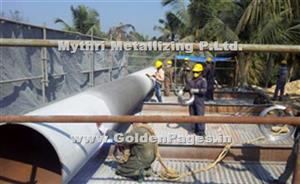
Spray Galvanizing
Atomized particles of molten Zinc are projected on to a Grit or Sand blasted steel surface from a special flame or arc pistol fed with Zinc wire. The process is often applied to structural components too large to be dipped in a galvanizing bath, and to structures which are likely to distort during hot dip galvanizing. Zinc coatings for iron and steel provide excellent corrosion resistance in most atmospheres, and in contact with many natural and synthetic substances. Zinc coatings are widely used to protect finished products ranging from structural steelwork for Chemical, Fertilizer, Refinery, Cement, Power plant, buildings, bridges, Pipe lines, etc.
The electrochemical relationship between zinc and steel enables zinc coatings also to protect steel at cut edges and at breaks in the coating by a sacrificial action.
Applications
All steel structures
Transformer Tanks
Radiators
Dairy coils
Communications towers
Steel Tanks
Wind Mill Towers
Electric Poles
Gates
Windows
Building Structures
Gutters in chemical - related industries
Advantages
Proven long term protection
Cold process
No size limitations
Ideal surface for painting
Site jobs possible
No hydrogen embrittlement
Preferred even under alkaline condition
Standards
IS : 5905 IS : 6586
BS : 5493

